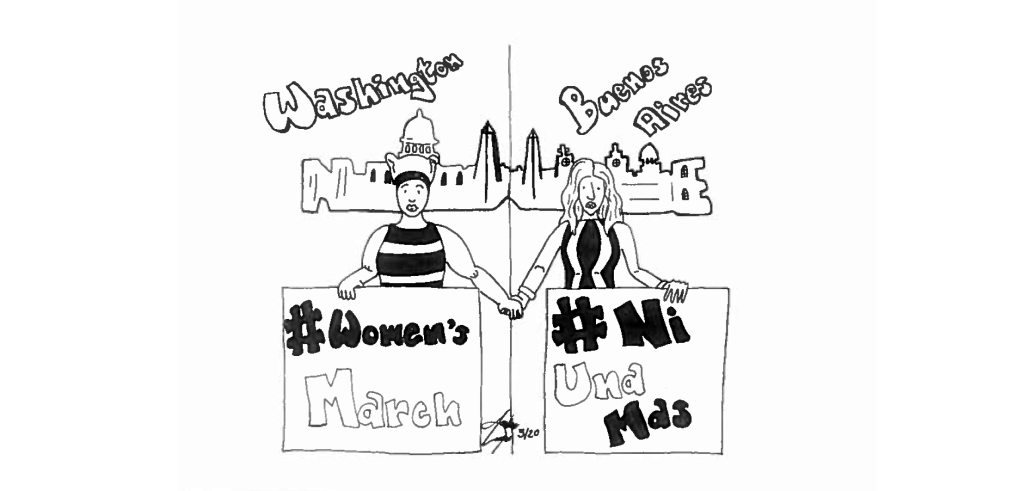On the day after the inauguration, the world witnessed a storm of women in pink hats standing up for what they believe. Yet the women of the Women’s March on Washington were not the first to unite, and they will certainly not be the last.
Over the past decade, women in Latin America have been at the forefront of this battle, most recently with the slogan #NiUnaMenos, or “not one less.” Originating in Argentina, this message denounces violence against women and has spread across Latin America to the United States. The goals of #NiUnaMenos and #WomensMarch have become interconnected in their quest for solidarity, justice and safety for the women of the world.
Ni Una Menos was launched by a group of Argentine journalists, artists and activists who demanded that women be protected from violent death at the hands of men. The inspiration for the hashtag arose from Mexican poet and activist Susana Chávez, who was murdered in 2011 and was known for her advocacy against gender-based violence, primarily “femicide,” in Mexico’s Ciudad Juárez.
The first Ni Una Menos demonstrations in Argentina were held June 3, 2015, in Buenos Aires’ Plaza del Congreso. Nearly 300,000 people showed up, with support from women’s rights groups, political organizations and the Catholic Church.
Violence against women in Argentina is a growing problem, with Argentina-based human rights nonprofit La Casa del Encuentro estimating that every 30 hours, a woman is killed in crimes ranging from rape to live burnings, usually committed by husbands, boyfriends, family members or acquaintances of the victim.
In the movement’s first triumphs following the 2015 rallies, Judge Elena Highton announced that the Supreme Court of Argentina would set up a specific registry for femicides. Beyond the protests, the movement has had a viral impact on the internet, with its call to serve as “a collective cry against machista violence,” according to its website.
Meanwhile, the Women’s March platform is best summarized by the mantra “Women’s rights are human rights.” Though it appears Ni Una Menos focuses on violence and the Women’s March focuses on civil and reproductive rights — which seem unrelated — it is important to note that violence against women is not exclusive to the countries of Latin America.
Rather, it is a global problem that affects women everywhere, including elite institutions similar to Georgetown. Recall the rape of an unconscious woman by ex-Stanford student Brock Turner in January 2015. When this resulted in a minor six-month jail sentence, of which he only served three, the voices of women united in protest. In doing so, women in the United States followed in the footsteps of Latin American women.
Connections between the two movements abound. On the actual day of the Women’s March, sister marches were held in Argentina, Peru, Colombia, Costa Rica and Mexico. Many wore pink hats while continuing their rhetoric of #NiUnaMenos.
It is imperative today, more than ever, that we in the United States recognize the value of maintaining relationships and learning from the rest of the Americas. What the Latin American movement has modelled for women is that telling the stories of victims does not need to be passive. By standing together and raising the collective voice of women, powerful and meaningful direct action can be taken against these injustices.
Latina women have taught us time and time again how to be strong in the face of adversity. As is evident by the incredible solidarity seen across Latin America and in the United States, we are stronger when we unite across borders.
This is important because although Latina women may seem far away, in reality they live all around us. We must celebrate the diversity that exists in our country and world and use it to our advantage. To do so, we must recognize and respect our differences, including racial, cultural and religious ones. We should use them to empower rather than separate us.
On March 8, women all across the world committed to an International Women’s Strike. This day was one where women joined in solidarity to fight for the issues affecting them and their sisters by being absent from their workplaces, their roles and showing the world what a day without women feels like. While the fight for women’s rights is certainly not over, the women of #NiUnaMenos and the #WomensMarch were united in showing the world that women standing together will prevail.
Nadia Guaman is a sophomore in the School of Foreign Service. She is a student fellow with the Latin America Initiative.




















